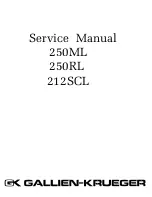
2.2
Instrument overview
2 – 5
In sine mode, this input is AC coupled above 0.016 Hz (10 s time con-
stant), and has an (AC) input impedance of 1 M
Ω
. A sine wave input
greater than 100 mVrms for frequencies above 2 Hz (500 mV below
2 Hz) will trigger the input discriminator. Positive zero crossings are
detected and considered to be the zero for the reference phase shift.
Note that, because the input is AC coupled, the discriminator circuit
actually triggers when the input signal crosses the DC average input
value in the positive direction.
When a user has a square wave or other TTL-like signals, the Ext. In
should be operated in TTL mode. In this configuration, the input is
DC coupled, and the input discriminator triggers on positive edges as
they cross
+
1 V. In TTL mode, there is no restriction on the reference
input duty factor, so long as the input pulses are at least 100 ns wide.
Operating in external mode, the user can select between locking to
the fundamental of the input frequency, or either of the first two har-
monics. Locking to
2f External
will cause the reference oscillator to
function at twice the external input frequency; locking to
3f External
will similarly cause the reference oscillator to operate at three times
the external input frequency. Note that, for harmonic operation, the
Range setting must correspond to the final frequency for the refer-
ence oscillator, which might not include the user’s external input
frequency.
2.2.1.4
Reference output
The SR124 reference oscillator drives the front-panel Ref. Out BNC
signal. This output can be configured as either sine wave or square
wave. The amplitude of the reference output can be set from 10 V
to 100 nVrms; at several points passive resistive attenuators are
switched in to reduce the signal amplitude while keeping a high
signal-to-noise ratio on the Ref. Out signal.
The Ref. Out signal can also be DC biased, allowing users to more
easily perform experiments such as di
ff
erential conductance mea-
surements without additional instrumentation. When enabled, the
DC Bias is added to the reference oscillator output; the range of DC
Bias is dependent on the reference amplitude, as the Bias and AC both
are routed through the same resistive attenuators. See section 3.4 for
the detailed interdependence of DC Bias and reference amplitude.
The rear panel Reference Output monitors are not shifted by the DC
Bias setting, and they are not attenuated by the amplitude setting;
these 4 “quadrant” monitors provide 1 V outputs for auxiliary use.
SR124
Analog Lock-In Amplifier
















































